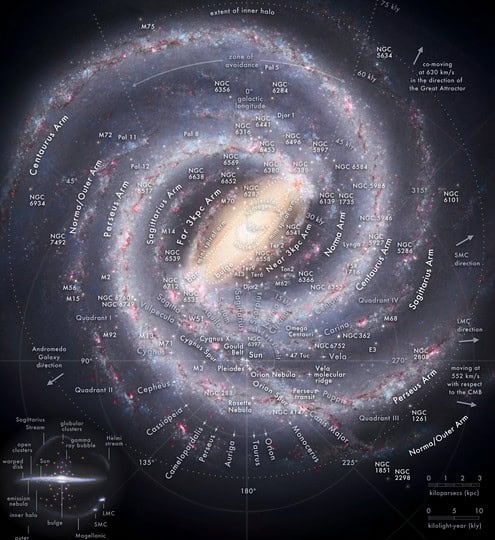
At present, there are additional combined reductions (ranging from 2% to 25%) that can be availed by 58,750 educational establishments. To determine which concession applies to all staff members of your educational institution, kindly access your personal Infoworks account.


Enroll in our professional retraining course now!
Enhance Your Skills in Quality Management
We are pleased to inform you that we can provide an additional discount for your educational institution. The exact discount amount depends on the number of your colleagues who have already enrolled in Infowork courses.
Currently, there are 58,750 educational institutions that are eligible for these additional discounts ranging from 2% to 25%. To find out the specific discount available for all employees of your educational institution, simply log in to your personal Infoworks account.


Course for professional retraining
Organizing the work of teacher-psychologists in preschool education institutions
We can apply your educational institution’s discount to this offer (it depends on how many of your colleagues have completed Infoworks courses).
Currently, there are additional cumulative discounts (ranging from 2% to 25%) available for 58,750 educational institutions. To find out the discount that applies to all employees of your educational institution, please log in to your personal Infoworks account.




Ecology of the Biosphere
Summary of the presentation by each slide:


A presentation on astronomy for Grade 11 students titled “Understanding the Composition of Galaxies within the Local Group” was conducted by Belousova Yulia Vyacheslavovna, an esteemed astronomy teacher at State Budgetary Educational Institution School № 10 in Syzran. The aim of the presentation was to provide students with a comprehensive understanding of the structure and composition of galaxies within the Local Group. Through this presentation, students were able to gain valuable insights into the vastness and complexity of our universe.


Slide 2
The study of space is currently the most rapidly evolving field in the world. It is in this field where the most astonishing discoveries are being made.
Investigating the known types of galaxies.
2) Creating diagrams illustrating the structure of galaxies known to modern science.
3) Examining the development of galaxies.


There are three main types of galaxies:
1. Elliptical (oval-shaped).
2. Spiral (with a central bulge and arms that spiral outward).
3. Irregular (with no distinct shape).
In addition, there are two transitional types:
1. Spiral galaxies with a bar-shaped structure at the center.
2. Lenticular galaxies, which have a disc-like shape but lack spiral arms.


Slide number 4. Every galaxy is made up of: Furthermore, there are:

Slide 5: The composition of spiral galaxies.
Within the core, you will find the presence of more mature and fainter stars, along with a supermassive black hole.
The spiral arms extend outwards from the galactic center. They consist of youthful stars, along with dust and gas.

Slide 6: The arrangement of a jumper galaxy.
It is a kind of spiral galaxy,
that possesses a bar
or a bulge. C
when viewed from the side, it appears spherical.
Surrounding the bar are stars and clusters of stars
and clusters of stars around the bar, an area known as the halo. A defining
feature of galaxies with
is that the spirals
the spirals do not extend away from the core,
but rather from the lintel, the bar.
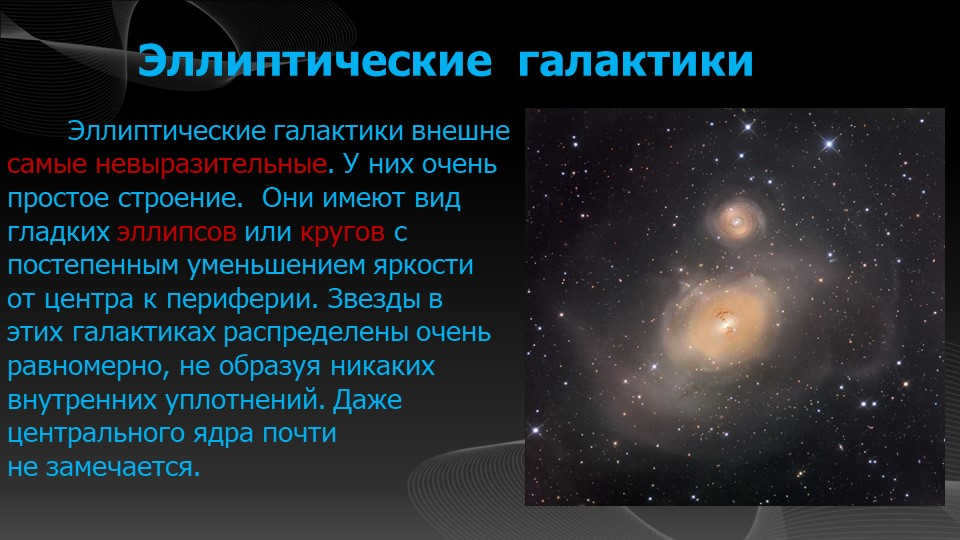
Slide 7: Elliptical Galaxies
Elliptical galaxies have a rather unremarkable appearance. Their structure is quite simple, taking the form of smooth ellipses or circles with a gradual decrease in brightness from the center to the periphery. The stars within these galaxies are evenly distributed, without any significant internal clustering. Even the central core is barely distinguishable as a central nucleus.
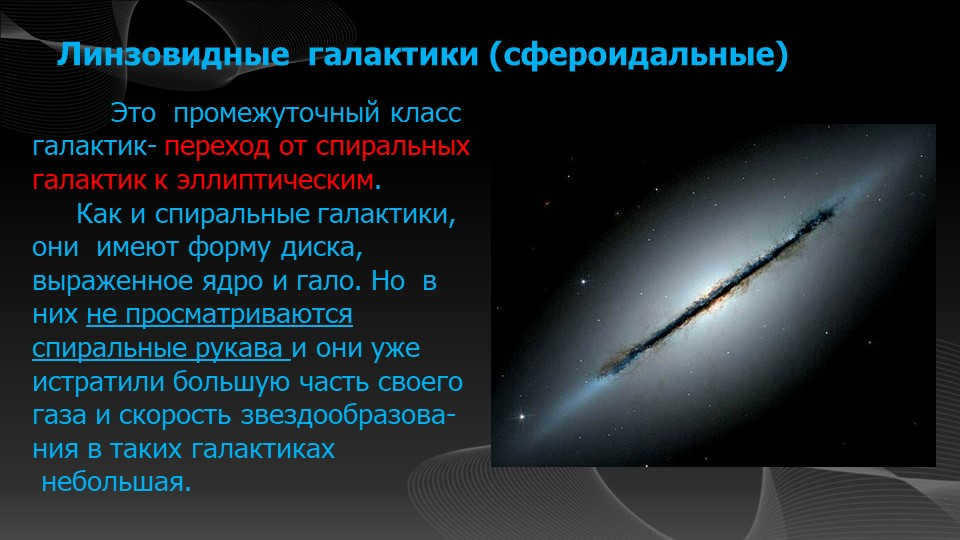

Slide 8 Lenticular galaxies (spheroidal galaxies)
These galaxies belong to an intermediate class, acting as a bridge between spiral galaxies and elliptical galaxies.
Similar to spiral galaxies, they possess a disk-like structure, a prominent nucleus, and a surrounding halo. However, they lack spiral arms and have already depleted a significant portion of their gas reserves, resulting in a reduced rate of star formation within these galaxies.
Furthermore, the star formation rate within these galaxies
is relatively low.
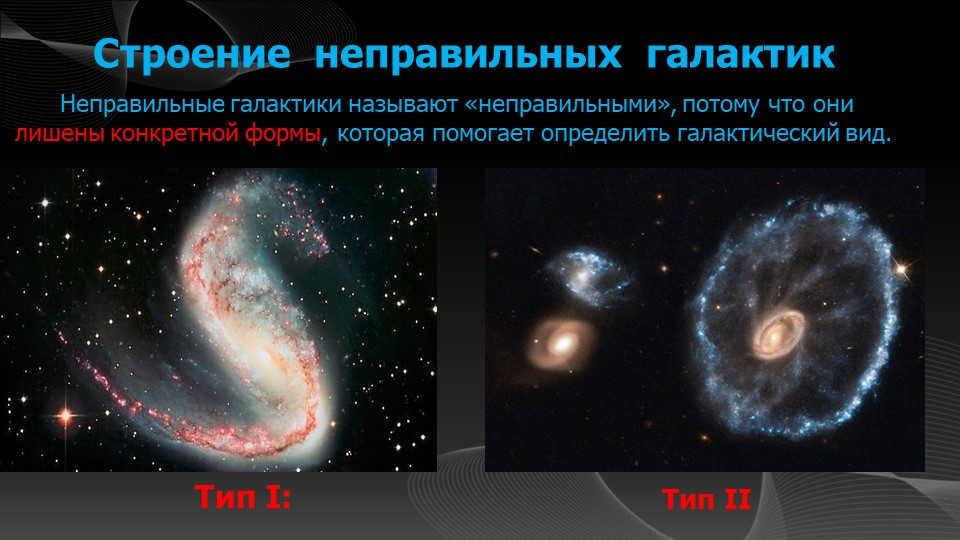

Slide 9: Structure of irregular galaxies
Galaxies that lack a specific shape that is used to classify galaxies are known as “irregular” galaxies.
Type I:
Type II
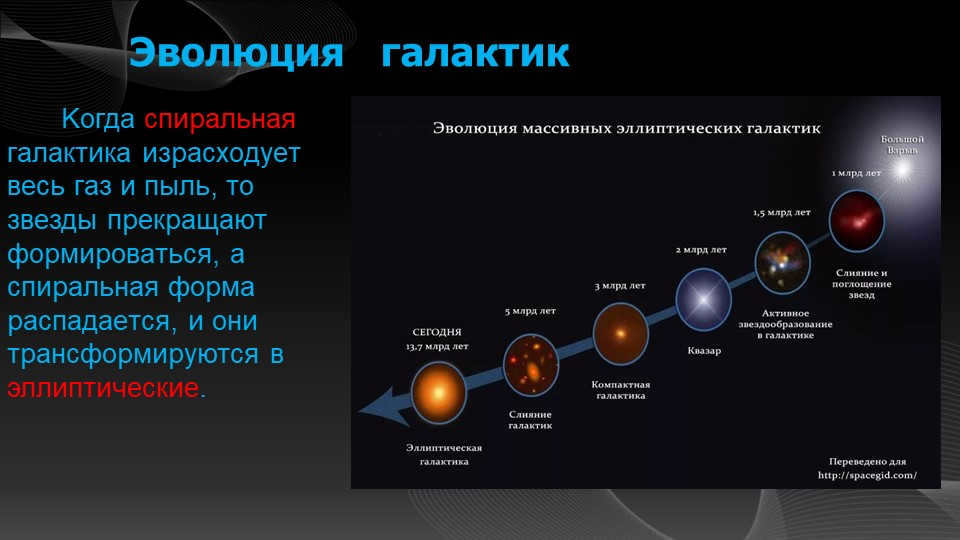

In the process of galactic evolution, when a spiral galaxy consumes all its gas and dust reserves, the formation of new stars ceases, resulting in the disintegration of its spiral shape and its eventual transformation into an elliptical galaxy.

Slide 11: Interacting Galaxies
Due to the immense gravitational forces at play, galaxies are drawn towards each other. This attraction sometimes leads to the collision or merging of nearby galaxies, which can spark the formation of new stars through violent means.
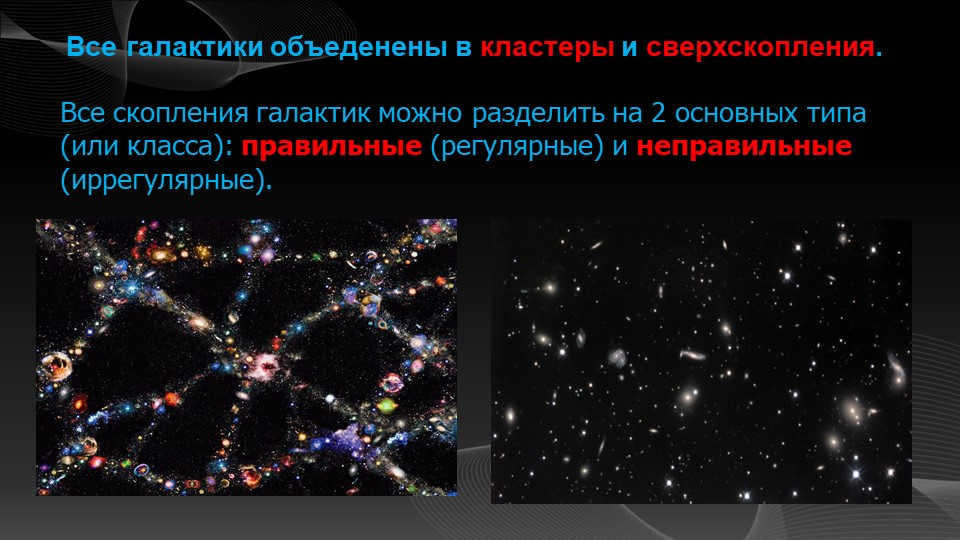

There are 12 slides that show how galaxies are arranged in clusters and superclusters. All galaxy clusters can be categorized into two main types: regular and irregular clusters. (irregular).
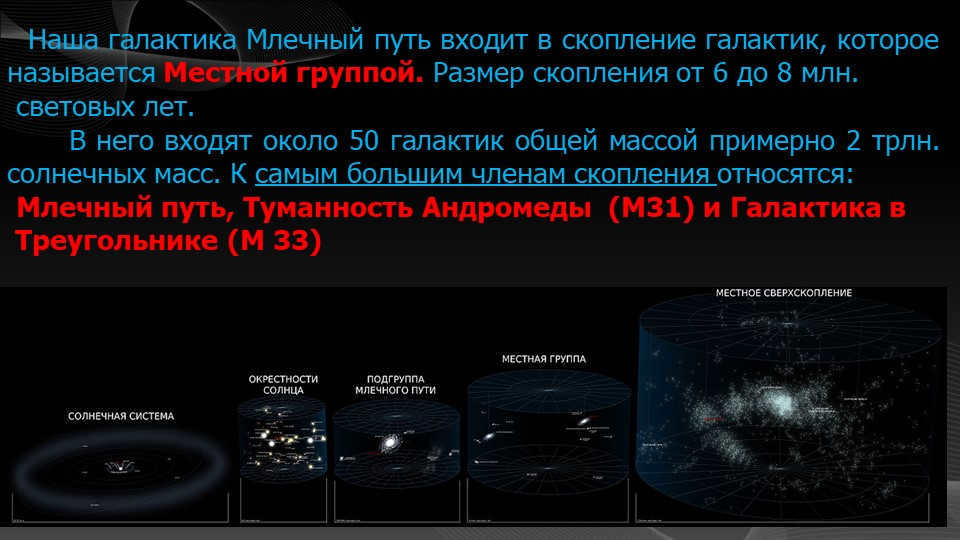

13 Slide The Local Group is a cluster of galaxies that spans between 6 million and 8 million light years. It consists of approximately 50 galaxies and has a combined mass of around 2 trillion solar masses. Some of the largest galaxies in the cluster are the Milky Way, the Andromeda Nebula (M31), and the Galaxy in the Triangle (M33).

The Local Group consists of 32 galaxies that have been categorized based on their proximity to our Milky Way galaxy. The distances to the closest galaxies have been measured with remarkable precision.
Among the galaxies in the Local Group, there is one small irregular galaxy that stands out due to its significant distance of 3 million light years from us.
As for the other galaxies in the Local Group, they are currently challenging to observe using telescopes due to their low luminosity.
Primarily, these galaxies are classified as dwarf and elliptical galaxies.

What is the number of galaxies in the Universe? Determining this is a highly challenging task. Numerous astronomers throughout history have endeavored to comprehend the quantity of galaxies existing in the Universe. The act of counting them appears to be an insurmountable feat. When the tally reaches into the billions, the process of addition becomes time-consuming. Additionally, we face the constraint of having a limited number of instruments at our disposal. In order to capture the finest image, a telescope must possess a substantial aperture (referring to the diameter of the primary mirror or lens) and be situated above the Earth’s atmosphere to prevent distortion caused by the air.
Hubble Field
The Hubble Extreme Deep Field is a well-known example that illustrates the point mentioned above. This remarkable image was created by combining photographs captured by the Hubble telescope over a span of ten years. NASA reports that the telescope focused on a tiny section of the sky for an incredible 50 days. To put it into perspective, if you were to cover the moon with your thumb, the area of the deep field would be about the size of a pinhead.
Through its extensive observation and accumulation of faint light over numerous hours, the Hubble telescope has managed to detect thousands of galaxies, both near and far. As a result, the images obtained from the telescope provide the most comprehensive view of the universe to date. So, even if this small region in the sky contains thousands of galaxies, one can only imagine the countless more that exist in other parts of the universe.
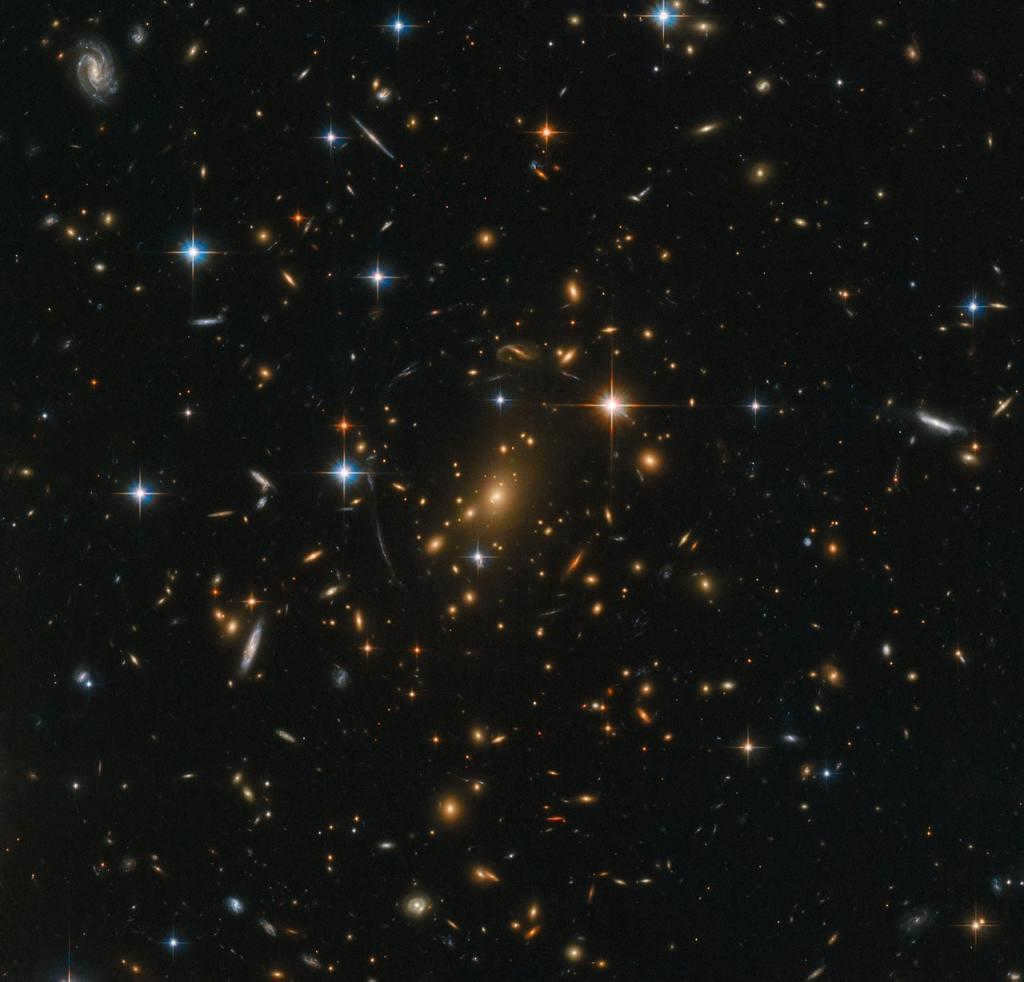
Opinions of Specialists
Though the assessments differ among specialists, the quantity of galaxies in the universe can be described using astronomical figures, ranging from 100 to 200 billion. Once the James Webb Space Telescope is launched in 2020, NASA is anticipated to uncover further details about the ancient galaxies in the universe.
Technology is truly amazing. According to current knowledge of astronomers, the Hubble telescope is the most effective instrument for tallying and estimating the number of known galaxies in the universe. The telescope was launched in 1990 but initially had a flaw in its main mirror, which was rectified during a visit by a space shuttle in 1993. “Hubble” has also undergone multiple upgrades and servicing missions, with its last mission taking place in May 2009. The question of whether the universe is infinite and how many galaxies and planets it contains remains unanswered, but it is likely that we will discover more in the future.
The Big Dipper
In 1995, a group of astronomers aimed their telescope at what initially appeared to be an empty area within the Big Dipper and conducted observations spanning over a period of ten days. The outcome of this endeavor was the astounding discovery of approximately 3,000 faint galaxies captured in a single frame, each of these galaxies having become incredibly dim, reaching a magnitude of around 30. To put this into perspective, Polaris, also known as the North Star, has a magnitude of only second. This particular section of the image was subsequently named the Hubble Deep Field, representing the farthest region ever observed in the entire universe.
Following the complete modernization of the aforementioned American telescope, astronomers decided to replicate the experiment twice. During the years 2003 and 2004, scientists were able to detect approximately 10,000 galaxies within a small area situated in the constellation Fornax.
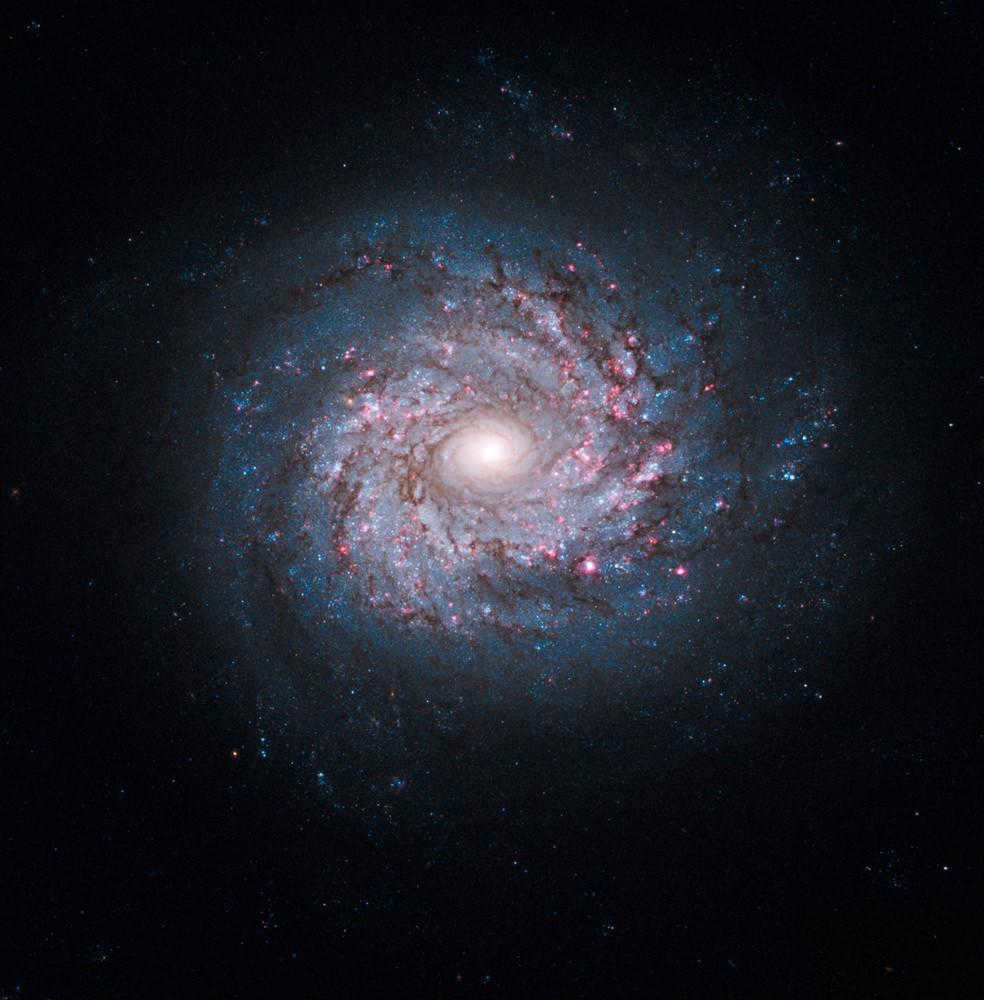
In 2012, once again utilizing enhanced instruments, scientists employed a telescope to observe a portion of the ultra-deep field. Even within this more limited field of vision, astronomers managed to identify approximately 5,500 galaxies. The scientists referred to this as an “extraordinary deep field.”
The Unseen Billions
No matter what tool is utilized, the process of calculating the number of galaxies in the universe is essentially identical. A specific section of the sky, captured by the Hubble telescope in this instance, is analyzed. By evaluating the proportion of this portion to the entire universe, it becomes possible to ascertain the total quantity of galaxies present in the universe.
The cosmological principle and the age of the universe
One instance of the cosmological principle in the examination of the universe is the cosmic microwave background – radiation that remains from the early stages of the universe following the Big Bang.
Observations of galaxies moving away from us and the expansion of the Universe reveal that it is approximately 13.82 billion years old. However, as the Universe continues to age and expand, galaxies will continue to move further away from Earth, making them increasingly challenging to detect.
The Universe is expanding at a rate faster than the speed of light (although this does not violate Einstein’s speed limit because the expansion is a result of the Universe itself, not objects traveling within it). Additionally, the universe is experiencing accelerated expansion.
The idea of the “observable Universe” is significant in this context. As per numerous specialists, after 1-2 trillion years, it will imply the presence of galaxies that exist outside the range of our Earthly observations.
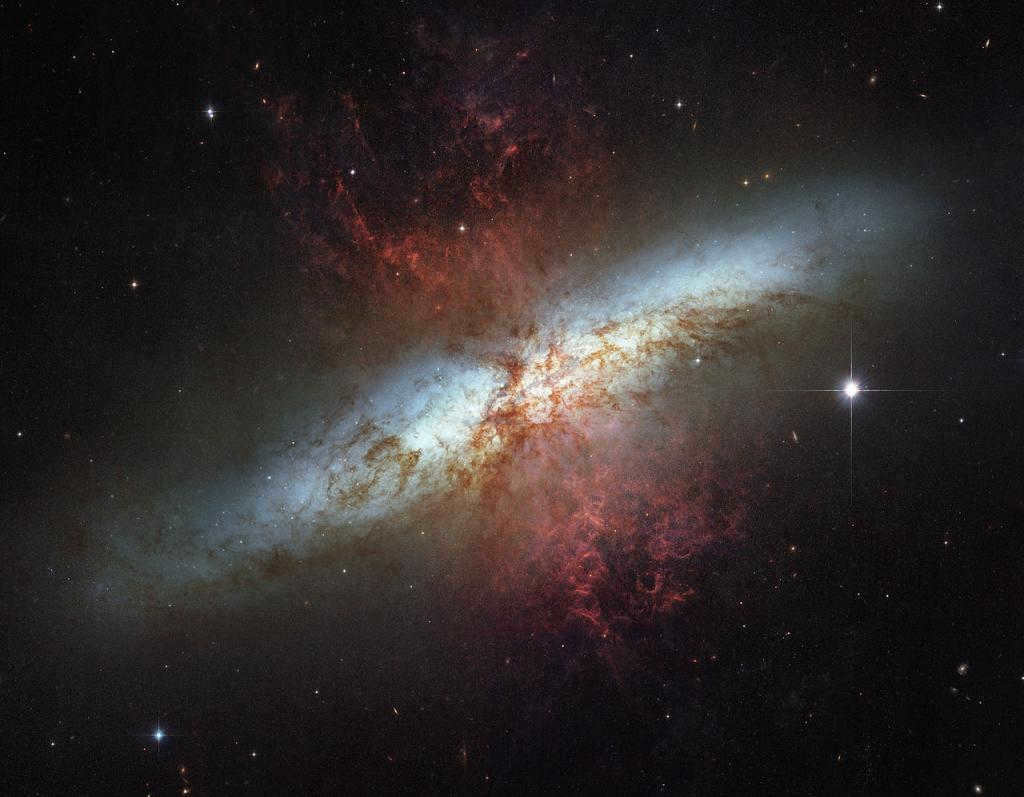
Shifting illumination
We are able to perceive solely the radiance emanating from galaxies that have traversed the vast expanse of space and approached the vicinity of the Milky Way. Nevertheless, this does not imply that these entities represent the entirety of the cosmos. Consequently, the notion of the “observable universe” is defined.
The destiny of the Milky Way
As time goes by, galaxies undergo transformations. The Milky Way is heading towards a collision with the neighboring Andromeda galaxy, and in approximately four billion years, they will unite. Subsequently, other galaxies within our nearby cluster will also combine. Experts in astronomy predict that the residents of these forthcoming galaxies will witness a universe that is shrouded in darkness.
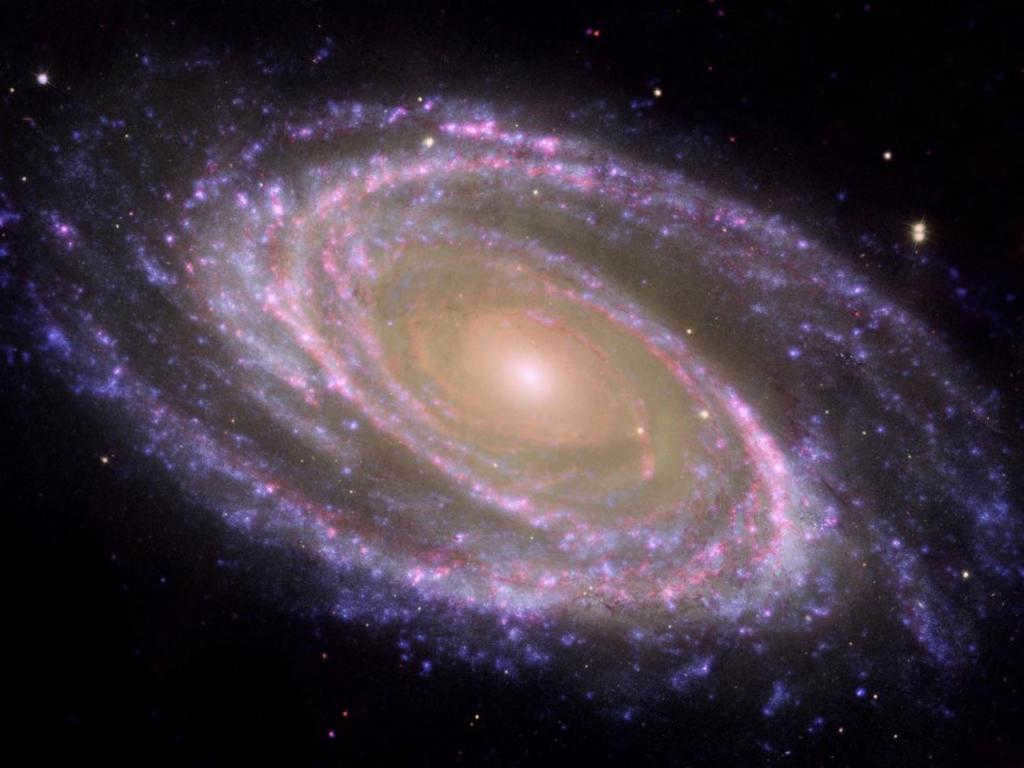
At the time the first civilizations emerged, they lacked any evidence of a universe containing a hundred billion galaxies. Consequently, our future generations will be unable to witness the expansion of the universe. It is highly likely that they will not even comprehend the occurrence of the Big Bang.
If we, as ordinary individuals, desire to ascertain the total number of galaxies and planets existing in the Universe, astronomers are primarily concerned with understanding how the universe itself was formed. According to NASA, galaxies offer a glimpse into the organization of matter in the cosmos – at least on a grand scale. Scientists are also intrigued by the various types of particles and the principles of quantum mechanics that exist within the observed spectra at the microscopic level.
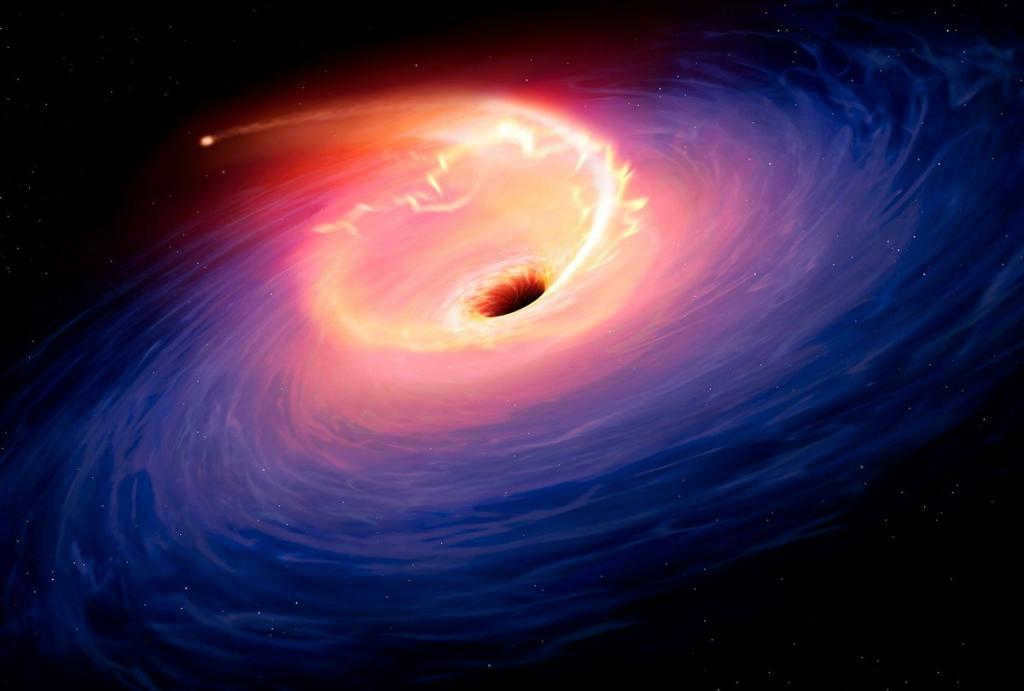
Origins of Early Galaxies
By examining some of the earliest known galaxies and contrasting them with contemporary galaxies, we can gain insights into their development and transformation. The Webb, an advanced telescope, will enable scientists to gather data on the types of stars that populated the very first galaxies. Further investigations, employing spectroscopy on numerous galaxies, will aid researchers in comprehending the formation and accumulation of elements heavier than hydrogen as star clusters took shape over the course of centuries. These inquiries will also unveil the intricacies of galactic mergers and shed light on a multitude of other phenomena.
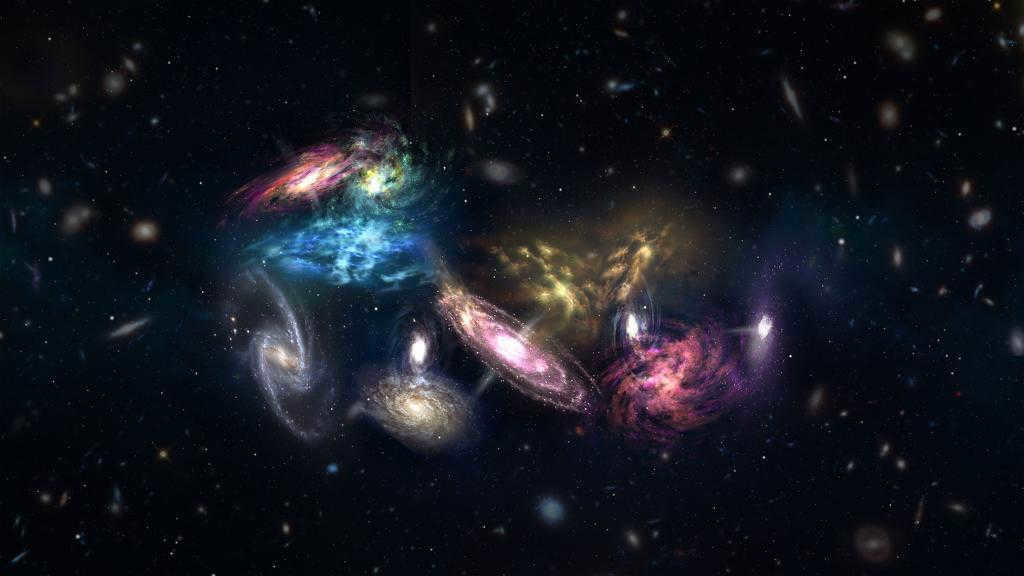
The Mystery of Dark Matter
The role of dark matter in the formation of galaxies is a topic that intrigues scientists. It poses a fascinating question. While some parts of the universe are observable, such as galaxies and stars, the majority of the cosmos is comprised of dark matter, which remains invisible. How many galaxies exist in the universe? The exact number of these celestial objects remains uncertain, but it is undoubtedly greater than one hundred billion.
Summary
When gazing up at the night sky and seeing the countless stars and the vast expanse of the Milky Way, one cannot help but feel a sense of insignificance in the presence of the vast universe that lies beyond our reach. Although most of it remains unseen to the naked eye, the observable Universe, expanding billions of light-years in every direction, contains an astonishingly large number of galaxies.
With advancements in telescopic technology, the number of known star clusters has grown exponentially, from thousands to millions, and from billions to trillions. By conducting a basic analysis using the most current technology available, it is estimated that there are approximately 170 billion galaxies in our universe. However, it is believed that there are likely at least two trillion galaxies yet to be discovered.
In the future, we will have the ability to count all the cosmic objects in the sky using our telescopes and capturing every photon emitted by the stars. However, due to the limitations of our telescopes, this task may not be feasible in reality. The size of our telescopes restricts the number of photons they can gather, which affects our ability to detect faint objects. Additionally, the amount of sky we can “cover” with a telescope is directly related to how faint of an object we can see. Furthermore, the presence of dark matter in certain parts of the universe obscures our view and prevents us from seeing certain objects. As a result, the farther away an object is, the dimmer it appears to us.
When we observe the universe, we are only able to see the part that is illuminated, without being able to see into the dark matter, stars, or galaxies. Researchers have gathered data on numerous faint and distant celestial objects, with the hope of gaining a better understanding of what these far-off worlds truly look like. As mere observers, we share in their anticipation and excitement.
The formation of galaxies is considered to be a natural step in the evolution of the Universe, occurring as a result of gravitational forces. According to scientists, approximately 14 billion years ago, a big bang occurred, resulting in a Universe that was uniform throughout. Over time, particles of dust and gas began to come together, merge, and collide, forming clumps that eventually developed into galaxies. The wide range of galaxy shapes can be attributed to the various initial conditions of galaxy formation. The accumulation of hydrogen gas within these clumps gave rise to the first stars.
Starting from the moment of nucleation, the galaxy initiates a process of contraction. This contraction phase of the galaxy typically lasts for approximately 3 billion years. Within this time frame, the gas cloud undergoes a transformation, eventually evolving into a star system. Stars are created through the gravitational compression of gas clouds. Once the central region of the compressed cloud reaches the necessary densities and temperatures for efficient thermonuclear reactions, a star is born. The interior of massive stars is where thermonuclear fusion of chemical elements heavier than helium occurs. These heavier elements are then released into the primary hydrogen-helium medium either through stellar explosions or the gentle outflow of matter from stars. The formation of elements heavier than iron occurs in spectacular supernova explosions. As a result, first-generation stars enrich the primary gas with chemical elements that are heavier than helium. These stars, being the oldest, primarily consist of hydrogen, helium, and a small amount of heavier elements. In contrast, second-generation stars have a more noticeable admixture of heavy elements, as they are formed from the already enriched primary gas.
The phenomenon of stellar birth occurs as the galaxy continues to compress, resulting in star formation closer to the galactic center. As stars form closer to the center, they tend to contain a higher concentration of heavier elements. This observation is consistent with the chemical composition of halo stars in our Milky Way galaxy as well as elliptical galaxies. Within a rotating galaxy, halo stars are formed during an earlier stage of contraction, before the rotational forces have significantly affected the overall shape of the galaxy. Globular star clusters in our Galaxy serve as evidence of this particular era.
When the protogalaxy’s compression ceases, the kinetic energy of the formed disk stars equals the energy of the collective gravitational interaction. This creates conditions for the formation of spiral structure and the birth of stars already takes place in the spiral arms where the gas is dense enough. These stars are the third generation. Our Sun is one of them.
The reserves of interstellar gas gradually diminish, leading to a decrease in the intensity of star formation. In a few billion years, when all the gas reserves are depleted, the spiral galaxy will transform into a lenticular galaxy composed of faint red stars. Elliptical galaxies have already reached this stage: all the gas within them was exhausted 10-15 billion years ago.
The age of galaxies is approximately equivalent to the age of the Universe. One of the mysteries in the field of astronomy revolves around the nature of galactic nuclei. A groundbreaking revelation was the discovery that certain galactic nuclei exhibit activity. This finding came as a surprise, as it was previously believed that the galactic nucleus consisted solely of a conglomerate of hundreds of millions of stars. However, it has been revealed that both the optical and radio emissions from some galactic nuclei can undergo rapid changes within a matter of months. This indicates that these nuclei release a tremendous amount of energy in a short period of time, surpassing the energy released during a supernova event by several hundred times. These specific nuclei have been coined as “active,” and the processes occurring within them are referred to as “activity.”
In 1963, astronomers made a groundbreaking discovery when they found a new type of objects located outside our galaxy. These objects have a similar appearance to stars, but what sets them apart is their incredible luminosity, which is many times greater than that of entire galaxies! What’s even more astonishing is that their brightness is not constant, but varies over time. The amount of radiation they emit is thousands of times more powerful than that of active nuclei. Scientists named these extraordinary objects quasars. It is now believed that some galaxies actually have quasars at their cores.
Article Author: Mikhail Karnevsky, 15.01.2013.
Updated by: Tatiana Sidorova, 14.02.2018.
Reproduction without an active link is strictly prohibited!
Questions from readers in the “Ask the Experts” section:
- Are the light emissions from distant galaxies younger or older?
- What exactly is galaxy sprawl?
- Why did galaxies suddenly appear right after the big bang?
- Why doesn’t the Black Hole pull stars in, but rather causes them to orbit around it?
The location of the solar system
From any location on Earth, humans can observe the Milky Way in the dark sky. It appears as a wide strip resembling a translucent white cloud. As our solar system is situated on the inner portion of Orion’s arm, we can only see a small section of the entire galaxy.
The sun occupies the outermost region of the galactic disk. The distance from our star to the center of the galaxy is 28,000 light years. It would take the Sun 200 million years to complete one orbit. In the time since its formation, the Sun has completed approximately thirty orbits around the galaxy.
Planet Earth occupies a distinctive position where the rotational speed of stars aligns with the angular rotation of the spiral arms. This interaction results in stars remaining within the arms and never straying out.
This type of rotational pattern is atypical for galaxies. Typically, spiral arms have a consistent angular velocity and rotate akin to spokes on a bicycle wheel. Meanwhile, the stars move at a contrasting pace, causing them to traverse in and out of the spiral arms.
The region known as the corotational circle, also referred to as the “belt of life,” is believed by scientists to be the only place where habitable planets can be found. This term, derived from the English translation of “zone of joint rotation,” describes an area with a scarcity of stars. The spiral arms surrounding this zone are characterized by intense radiation, making them inhospitable for life. Consequently, according to this hypothesis, the number of systems capable of supporting life is extremely limited.
Galactic cores
The nucleus, the central region of a galaxy, is the most densely packed part of a star system. It is easily identifiable in galaxy images due to its high brightness. Nuclei are present in all types of galaxies except for fake and most dwarf galaxies. Within a radius of about a thousand light-years from the galactic center, the nucleus contains not only stars but also interstellar gas and numerous regions of young stars, forming a rotating disk of nuclei. The most fascinating characteristic of nuclei is their activity, which cannot be explained solely by the presence of ordinary stars and gas. In a small percentage of highly luminous galaxies, active nuclei exhibit non-stationary processes that release massive amounts of energy. In some cases, the power of energy release in the nucleus can exceed 1,037 watts, comparable to or even greater than the total radiative power of all the stars in the Galaxy combined, although typically it is still one or two orders of magnitude lower.
The form of energy release in nuclei, as well as the observed signs of activity, can vary. There is the rapid movement of gas at speeds of thousands of kilometers per second, the intense non-thermal radiation of non-stellar origin across different parts of the electromagnetic spectrum – from X-rays to radio waves, the generation of focused plasma jets, and the emission of high-energy elementary particles that contribute to the strong radio emissions from the galaxy. A characteristic feature of active galactic nuclei is the variability of their emissions over different time periods, ranging from a few days or even hours to several years (see Figure 5).
There are various categories for galaxies with active nuclei. These include Seyfert galaxies, radio galaxies, quasars, and lacertids. Each of these types exhibit unique observable features when it comes to their nuclear activity. However, in all instances, the source of intense nuclear energy is significantly smaller in comparison to the overall size of the galaxy (far less than a light-year).
The central element of such a source is considered to be a supermassive black hole descending at a velocity near the speed of light, initially sparse medium in its proximity (such medium can be interstellar gas near the disk of the core or gas that was part of stars and refracted by the black hole’s gravitational field). This theory is supported by the discovery in the cores of large galaxies of various massive objects (likely black holes) that emit no visible radiation but generate an exceptionally strong gravitational field. Their masses range from several million to several billion times that of the sun. Theoretically, the kinetic energy of falling matter transferred to it by the gravitational field of the black hole could be ten times greater than the energy produced by any thermonuclear reaction in matter. From this perspective, the activity of the core is connected to different mechanisms of converting the energy of falling matter into other forms. In this scenario, the galactic core can be in an active or dormant state depending on the presence of matter streams flowing into the black hole.
The center of our galaxy, similar to the nearby Andromeda Nebula, is relatively stationary, although there have been discoveries of massive black holes at the cores of these galaxies (Figure 6). The closest spiral galaxy with an active core is Seyferta NGC 1068, situated approximately 50 million light-years away in the constellation China. The nearest elliptical galaxy with an active core is the radio galaxy NGC 5128 in the constellation Centaurus. Its distance is significantly smaller.
Warzone
Galactic Cluster NGC474
NGC474 is classified as an elliptical galaxy and is located in the constellation of Pisces.
It was first observed by William Herschel in 1784. The presence of multiple radiant shells showcases the surprisingly intricate composition of this galactic cluster.
If the South Wheel Galaxy appears to be a typical active galaxy, then NGC474 is a prime example of what elliptical galaxies should not resemble. The image presented here is not a fictional representation inspired by a science fiction novel, but an actual galaxy that is being torn apart by the gravitational pull of the spiral galaxy located behind and above it. However, it is the presence of thin layers of gas and dust that give this galaxy its peculiar jellyfish-like appearance, and it is this feature that suggests that many, if not most, known galaxies possess similar gas shells. Scientists believe that these gas shells are the result of past collisions with other galaxies, relatively speaking.
The origin of galaxies
Galaxies came into existence shortly after the formation of stars. It is believed that the first galaxies emerged no more than 150 million years after the Big Bang. In January 2011, a group of astronomers analyzing data from the Hubble Space Telescope announced the possible sighting of a galaxy whose light broke free into space 480 million years after the Big Bang. In April, another team of researchers found a galaxy that was likely already well-developed when the early universe was approximately 200 million years old.
The conditions for the formation of stars and galaxies were established well before their actual emergence. When the Universe reached an age of 400,000 years, the plasma in outer space transformed into a blend of neutral hydrogen and helium. This gas remained too hot to condense into the molecular clouds necessary for star formation. However, it was accompanied by dark matter particles, initially distributed unevenly throughout space – some regions denser, others sparser. These dark matter particles did not interact with the baryonic gas, allowing them to gravitationally attract each other and form regions of higher density. As per model calculations, approximately one hundred million years after the Big Bang, dark matter clouds the size of our current solar system had materialized in space. Over time, these clouds merged to form larger structures, in spite of the universe’s expansion. Consequently, clusters of dark matter clouds and subsequently clusters of these clusters were formed. These structures drew in cosmic gas, offering it the opportunity to condense and collapse. In this manner, the first supermassive stars emerged, which subsequently exploded as supernovae and left behind black holes. These explosions enriched the cosmic environment with heavier elements than helium, which facilitated the cooling of collapsing gas clouds and enabled the formation of less massive second-generation stars. These stars could exist for billions of years and, with the assistance of dark matter, form gravitationally bound systems. This is the process through which long-lasting galaxies, including our own, came into existence.
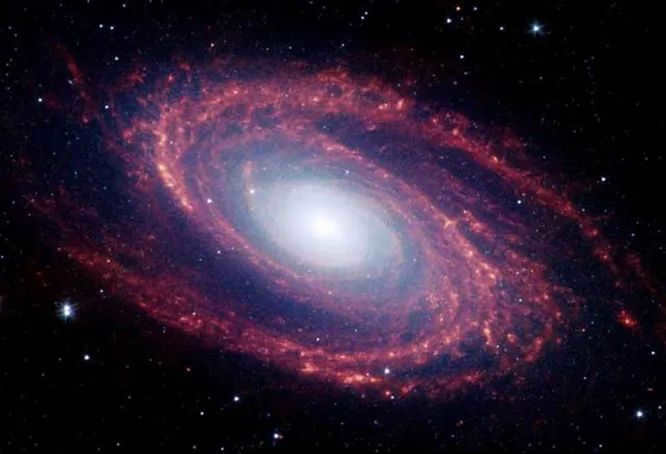
“The fog still conceals many details of galactogenesis,” remarks John Cormendi. – Specifically, the role of black holes remains elusive. Their masses span from tens of thousands of solar masses to the current record of 6.6 billion solar masses, held by a black hole residing at the core of the elliptical galaxy M87, positioned 53.5 million light years away from the Sun. Elliptical galaxies typically have bulges composed of aging stars surrounding the central black holes. In contrast, spiral galaxies may lack bulges entirely or possess flat imitations known as pseudobulges. The mass of a black hole is generally three orders of magnitude smaller than the mass of the bulge, assuming it is present. This correlation is supported by observations encompassing black holes with masses ranging from one million to one billion solar masses.”
According to Prof. Cormendi’s findings, galactic black holes expand their mass through two distinct mechanisms. One of these involves the absorption of gas from the outer zone of the galaxy by a black hole situated within a fully-formed bulge. When a galaxy merger occurs, the influx of this gas intensifies significantly, leading to the occurrence of quasar flares. As a consequence, both bulges and black holes evolve in tandem, thereby accounting for the observed correlation between their respective masses (although there may exist additional mechanisms that are currently unknown).
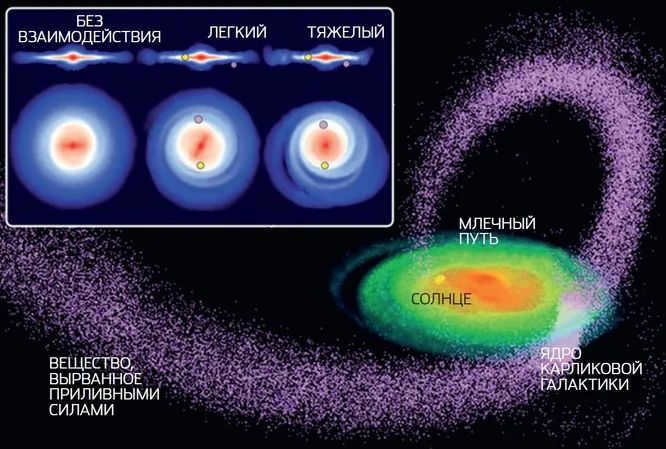
A team of scientists from the University of Pittsburgh, the University of California at Irvine, and Florida Atlantic University have conducted a study simulating the collision between our galaxy, the Milky Way, and the precursor of the Sagittarius Dwarf Elliptical Galaxy (SagDEG). The researchers examined two possible scenarios of the collision, one involving a light SagDEG with a mass of 3×10^10 solar masses, and the other involving a heavy SagDEG with a mass of 10^11 solar masses. The image displayed above illustrates the results of 2.7 billion years of Milky Way evolution, both with and without interaction with the dwarf galaxy in its different variants.
Another topic to consider is galaxies that lack a central bulge and galaxies that possess pseudobulges. The mass of these central black holes typically falls within the range of 104-106 solar masses. As Prof. Kormendi explains, these black holes are primarily fueled by gas through random processes that take place in the vicinity of the hole, as opposed to being fueled by gas from the entire galaxy. Consequently, the growth of these black holes occurs independently of the galaxy’s evolution or the presence of a pseudobulge, which explains the absence of any correlation between their respective masses.
Common characteristics of galaxies
Galaxies are intricate in their composition and structure. The smallest ones have a number of stars comparable to the large star clusters in our Galaxy, but they are much larger in size: even the smallest galaxies have a diameter of several thousand light-years. Giant galaxies are a hundred times larger. Galaxies do not have well-defined boundaries; their brightness gradually decreases as they move from the center outwards, so the concept of size is not strictly defined. The visible size of galaxies depends on the telescope’s ability to detect their outer regions, which are of low brightness compared to the glow of the night sky, which is never completely dark. In dim light, the outer parts of galaxies become less noticeable. Modern technology allows us to capture regions of galaxies with a brightness less than 1% of the brightness of the night sky. To objectively assess the size of galaxies beyond a certain point, a certain surface brightness threshold is conventionally accepted, or what is called an isophote (a line along which the surface brightness has a constant value). Often, this brightness threshold is taken as 25 stars per square angular second in the photographic region of the spectrum. Its corresponding brightness is ten times less than that of the night sky, which is considered “no light at all.” The brightness of the central regions of galaxies can be several hundred times higher than the threshold.
The luminosity
of galaxies (i.e. the total radiative power) exhibits a wide range of variation, surpassing even their
size. It spans from a few million solar luminosities (Lc) for the smallest galaxies to several hundred billion Lc for the largest ones.
This value is roughly indicative of the total number of stars or the overall mass of the galaxy. Our own galaxy, for example, possesses a luminosity in the tens of billions range. However, within the same galaxy, the luminosity can differ significantly, depending on the observed region of the electromagnetic spectrum. Hence, observations at different wavelengths play a crucial role in the study of galaxies.
The different types of galaxies seamlessly transition as we move across the spectrum, from radio waves to gamma rays (Fig. 5).
This can be attributed to the fact that various objects of distinct nature make the main contribution to the galactic emissions at different wavelengths.
Globally, galaxies can also exhibit a considerable range in terms of their mass and luminosity, spanning several orders of magnitude. For instance, large globular clusters can have masses in the millions of solar masses, while some elliptical galaxies can reach thousands of billions of solar masses.
In addition to
stars with different masses, chemical compositions, and ages, each galaxy
contains a slender and slightly magnetized interstellar medium (consisting of gas and dust) that
is permeated by high-energy particles (known as cosmic rays). The proportions
of mass associated with the interstellar medium and radio emission power are also
among the most significant observed characteristics of galaxies. The total mass of the interstellar
medium can vary greatly from one galaxy to another, typically ranging from a
few tenths of a percent to 50 percent of the total mass of stars (and in rare cases,
even gas can outweigh the mass of stars)
The quantity of gas present in a galaxy
is a highly important property that influences the activity of processes within galaxies, particularly the formation of galaxies.
galaxies, and specifically the process of star formation
Literature
Reception
The season garnered widespread praise from critics, earning a score of 85 out of 100 based on 16 reviews from Metacritic. It also secured a spot on the top ten lists for 2008 and 2009 by esteemed publications including the Chicago Tribune, San Francisco Chronicle, The Star-Ledger, Time, and TV Guide.
Season 4 was nominated for a total of eleven Emmy Awards. “Season 4.0” received six nominations at the 60th Primetime Emmy Awards, including Best Screenplay for a Drama Series (Michael Angeli for “Six of One”), Outstanding Cinematography for a One-Hour Series (Stephen McNutt for razor), and Outstanding Single-Series Camera Editing for a Drama Series (“He Who Believes in Me”). It also received a nomination for Outstanding Sound Editing for a Comedy or Drama Series (One Hour) for the episode Razor. The show won in the categories of Outstanding Special Visual Effects for a Series (“Someone Who Believes in Me”) and Outstanding Special Class – Live Entertainment Short Program (” Razor Flashbacks“).
“Season 4.5” received five nominations at the 61st Emmy Awards, with the episode “Breaking Dawn, Part 2” receiving all nominations. These included Best Directing for a Drama Series (Michael Rymer), Outstanding Single-Camera Picture Editing for a Drama Series, Outstanding Sound Editing for a Comedy or Drama Series (One Hour), and Outstanding Special Visual Effects for a Series. The show won the award for Best Sound Editing for a Series.
During the course of its 10 regular episodes, the popular TV show "Battlestar Galactica" obtained an average Nielsen rating of 1.7 and attracted 2.2 million viewers. These figures indicate a notable 13% rise in household ratings and an 11% increase in total viewership. The final episode of the series, which garnered 2.4 million viewers, became the most-watched episode in over three years.
The Milky Way, our vast cosmic abode
Galactic clusters, formed by the gravitational pull of multiple star systems, are known as galaxies. This basic definition encapsulates the true essence of this celestial phenomenon. Galaxies can vary in size, ranging from a few billion stars to gigantic behemoths housing trillions of stars.
For instance, there is the Small Magellanic Cloud, a dwarf galaxy containing around 1.5 billion stars. On the other end of the spectrum, we have the NGC 6872, a spiral galaxy of immense proportions. Due to its colossal size, it is challenging to determine the exact number of stars it harbors, but it undoubtedly falls into the trillions.
To grasp the sheer enormity of this cosmic giant, let’s compare it to our own immense celestial home – the Milky Way. Within the Milky Way lies our very own Solar System:
- The Milky Way is not a small formation; it has a diameter of 100-120 thousand light years.
- If you were to circumnavigate the galaxy NGC 6872 along the same route, it would take at least 500 thousand light years.
By the way, many galaxies are connected by gravity and rotate in sync. In our galaxy cluster, we have Andromeda (with a diameter of 200 thousand light years), Triangle galaxies (50 thousand light years), and several satellite formations known as dwarf galaxies.
So, now that we’ve covered galaxies, let’s discuss the universe itself and understand the difference between a galaxy and the universe.
The Milky Way Galaxy is a part of a group of nearby galaxies called the Local Group, and it forms a cluster with them. Our galaxy is one of the biggest in the Local Group. The Andromeda Galaxy, which is also a member of the Local Group, is the farthest object that can be seen with the naked eye. The Local Group contains 25 galaxies that are spread out across a distance of 3 million light-years. A cluster of galaxies is held together by the force of gravity. The larger galaxy clusters include the Virgo Cluster, which has several thousand objects, and the Cluster in the constellation Veronica’s Hair, which has about 1000 bright elliptical galaxies and several thousand smaller objects. Our Galaxy, along with its neighboring galaxies in the Local Group, is slowly moving toward the Virgo Cluster.
The families of galaxy clusters are grouped together. A Local Supercluster, called the Local Cluster of clusters, is a formation that consists of both the Local Group and the Virgo Cluster. The Virgo Cluster is where the center of mass is located. The other supergroup is situated in the constellation Hercules, approximately 700 million light years distant. The super clusters are separated by vast empty spaces and create a sponge-like structure in the Universe.
Description of the galaxies that compose the Local Group
The Milky Way, our Galaxy, is made up of around 100 billion stars. It is comprised of 4 spiral arms, filled with stars, gas, and dust. The stars in the center of the Galaxy, within a distance of 1000 light years, are densely packed together. In the very center of the Galaxy, there exists a mysterious and incredibly powerful source of energy. It is believed that a black hole may reside at the core of the Galaxy. The Galaxy itself is in constant rotation, with the inner regions spinning at a faster rate than the outer regions. Surrounding the Galaxy’s disk is a halo cloud of matter that cannot be seen.
Approximately 90% of the Milky Way Galaxy is invisible to us. The Large and Small Magellanic Clouds, our neighboring galaxies, are attracted to and eventually absorbed by the invisible halo of the Milky Way Galaxy.
These are the defining characteristics of the Milky Way Galaxy.
* Stars that are further away in the flat component have longer rotation periods, while those closer to the center have shorter periods. The central region of the Galaxy rotates as a solid body.
? – represents the average distance of the subsystem objects from the galactic plane, measured in kiloparsecs (kpc); T denotes the age of the stars included in the subsystem, measured in years; M represents the mass of the subsystem as a percentage of the total mass of the Galaxy; N is the estimated total number of objects.
The elliptical shape of the galaxy nucleus has dimensions of 4.8 ? 3.1 kpc, and it contains approximately 3-E10 7 stars.
On the other hand, the central core of the galaxy, also elliptical in shape, has dimensions of about 15 ? 30 pc and houses around 3-E10 6 stars.
The galactic nucleus itself has a diameter of approximately 1 ps and at its center lies a compact object, which is a black hole with a mass of 108-09 solar masses.
There are different types of star clusters, which are relatively close groups of stars:
Scattered star clusters have diameters ranging from 1.5 to 15 ps, and their ages can vary from a few million to a few billion years. The number of stars in these clusters can range from a few tens to a few thousands. These clusters belong to a subsystem of the galactic plane.
Globular star clusters, on the other hand, have diameters ranging from 15 to 200 ps. They are much older, with ages of 8-10 billion years, and contain a larger number of stars, ranging from 10 5 to 10 7. These clusters belong to the intermediate and extreme spherical subsystems.
Overall, the total number of stars in the galaxy amounts to 1.2-10 11.
This text serves as an introduction to the topic.
What is the Milky Way?
The Milky Way, an enigmatic and stunning celestial phenomenon, captivates our imagination as it gracefully extends across the sky like a radiant necklace. Throughout history, humans have gazed at this awe-inspiring spectacle with wonder and admiration, just as we do today.
What does the term “Local Group of Galaxies” mean?
The Local Group of galaxies refers to a cluster of approximately 30-40 galaxies that includes our own Milky Way galaxy and the Andromeda Nebula galaxy. Astronomers have classified this collection of galaxies as the Local Group, with the most distant galaxy in this group being located a considerable distance from the Sun.
GALAXIES 2: THE LOCAL GROUP
Galaxies 2: THE GROUP OF STARS CLOSE BY Galaxies come in a variety of sizes, ranging from small dwarf galaxies that are much tinier than the Milky Way, to massive galaxies that are much larger than the Milky Way. The Sun is just one of the many millions of stars that make up the Milky Way Galaxy, which has a diameter spanning over 100,000 light-years.
GALAXIES 3: CLUSTERS AND SUPERCLUSTERS
Galaxies 3: GROUPS OF GALAXIES AND SUPER GROUPS Most galaxies are part of a larger cluster. The nearest galaxy cluster to our Local Group is located in the constellation Virgo and is home to more than 3000 galaxies. It can be observed as a peculiarly shaped spot in the sky.
THE MILKY WAY
The Sun is just one of the countless stars that exist within the vast expanse of the Milky Way, which is a magnificent spiral Galaxy spanning approximately 100,000 light-years. Positioned within one of the spiral arms, the Sun resides in this awe-inspiring Galaxy. Rotating gracefully, the Galaxy completes a full revolution in a remarkable timespan of around 240 million years. Fascinating, isn’t it?
GALACTICS
GALACTICA stood out among the other military bands in St. Petersburg during the late 1960s. Not only were they leaders in terms of their professional level, technical equipment, and the accuracy of their cover versions of Western hits, but they also surpassed their peers in professionalism and technical skills.
What is the origin of the Milky Way?
How did the Milky Way come into existence? Alcmene, afraid of Hera’s envy, brought the newborn Heracles to the field beneath the walls of Thebes. It was then that Athena, under the influence of Zeus, subtly suggested to Hera to take a stroll in that very field. “Oh, look, my beloved! Such a beautiful and powerful child!” she exclaimed.
Discover Your Unique Coaching Style
As you progress in your coaching journey, you will naturally develop your own unique ways, habits, and techniques that align with your coaching style. For instance, you might prefer to kick off each coaching session by revisiting the objectives that were established during the initial consultation.
The Local Group, an assemblage of galaxies including our very own Milky Way, showcases the beauty and complexity of our cosmic neighborhood. While the galaxies within the Local Group are in constant motion relative to each other, they are bound together by the force of gravity and have coexisted within a relatively small region spanning approximately 6 million light-years. Scientists believe that all the members of the Local Group share a common origin and have been evolving together for an astounding 13 billion years.
Local Group galaxies attract a lot of attention from astronomers due to two main reasons: their ability to be studied in depth and their significant impact on our own Galaxy, as well as the reciprocal influence they experience. The Local Group, along with other nearby galaxy groups and larger galaxy clusters, forms a larger collective known as the Local Supergroup of galaxies. This system has a flattened shape with a diameter of approximately 100 million galaxies and a thickness of around 35 million sv years. Located at its center is a massive cluster of galaxies in Virgo, which is situated 50 million sv years away from us.
Within the Local Group, there are two notable galaxies in terms of their mass and luminosity: the smaller spiral galaxy in the constellation of Triangle (M 33) and the irregular galaxy known as the Large Magellanic Cloud (LMC). Following them in terms of decreasing luminosity are the irregular galaxies Small Magellanic Cloud (SMC), IC 10, NGC 6822, IC 1613, and WLM, as well as two spheroidal satellites of the Andromeda Nebula – M 32 and NGC 205. The rest of the galaxies in the Local Group are relatively less luminous. Approximately half of the mass of the Local Group is contained within a sphere with a radius of around 1 million sv years, and the boundary of the group is approximately 3 million sv years away from its center. Near this boundary, there are three smaller systems – Aquarius, Tucana, and Sag DIG – whose membership in the Local Group is still uncertain. It is worth noting that not only these systems, but also many other galaxies within the Local Group are named after the constellations in which they are observed, such as Fornax, Draco, Sculptor, Leo I, Leo II, and more. While these galaxies may have other designations in various galaxy catalogs, astronomers often refer to them by their constellation names, such as the galaxy in Furnace (Fornax) or the system in Dragon (Draco).
The spiral galaxy M 33 in the constellation Triangle is the third largest and most massive galaxy in the Local Group. It does not appear to have any satellites, although there are some smaller galaxies that are closer to M 33 in terms of sky projection than to M 31. However, the Triangle Spiral (M 33) is much less massive than the Andromeda Nebula (M 31), so even the distant satellites of M 31 are influenced by it rather than its less massive neighbor. The Local Group consists mainly of spiral, irregular, and dwarf galaxies, which is typical for small and sparsely populated groups like this. Unlike richer clusters, the Local Group does not have large elliptical galaxies. The only true elliptical galaxy is M 32, which is a close companion of the Andromeda Nebula. The remaining spheroidal (type Sph) and dwarf spheroidal (dSph) galaxies are not considered true elliptical systems because they are less dense, have a weaker concentration towards the center, and contain interstellar gas and young stars.
The Local Group is surrounded by other small clusters of galaxies that are its nearest neighbors. One of these clusters, which can be observed in the direction of the constellations Pump and Sextant, is located 5.5 million light-years away from the center of the Local Group. The Sculptor group, consisting of a collection of small galaxies, is located 8 million light-years away, while another known group, which includes the large spiral galaxy M 81 and the interacting galaxy M 82 with its intense star formation, is located 11 million light-years away. Initially, the Pump-Sextant group was believed to be part of the Local Group due to its proximity to us. However, after studying the movement of its main members – the small galaxies NGC 3109, Pump, Sextant A, and Sextant B – experts have determined that this group is actually independent and slowly moving away from the Local Group.
Milky Way Subgroup.
Situated within the core of our Galaxy, encompassed by interstellar gas and dust formations, we still lack precise visual representation of our stellar system, and even the ability to identify all its neighboring counterparts, particularly those veiled by the Milky Way belt. Infrared telescopes have recently discovered a number of galactic satellites, as the extended wavelength radiation emitted by stars can more readily traverse interstellar dust.
The Magellanic Clouds possess a significant amount of gas and youthful stars: despite their overall mass being 10 times less than our Galaxy, they contain a nearly equal amount of interstellar material. The BMO showcases extensive regions of stellar formation, which are even more accessible to study compared to the dusty Milky Way. In the BMO, numerous young star clusters housing massive stars and various remnants of supernova explosions have been discovered. The BMO was the site of the only supernova observed in the 20th century within the Local Group, occurring in 1987.
For reasons that are still not fully understood, there was an eruption of star formation in the BMO around 4 billion years ago. The evidence of this event is preserved in the form of numerous star clusters that are approximately the same age. It is possible that the cause of this phenomenon was the collision or interaction between the Clouds or between the Clouds and the Galaxy. By examining double galaxies that are further away, scientists have observed that their close encounters often lead to a higher rate of star formation within them.
Subgroup of the Andromeda Nebula.
In 2003, scientists made an exciting discovery in the Andromeda Nebula – a new companion called And VIII. This companion was found in the background of the nebula’s disk, near the location of the galaxy M 32. Due to the strong tidal influence of the host galaxy, And VIII has been heavily eroded and is difficult to observe in conventional photographs. Its dimensions are approximately 10 kpc in length and only a few kiloparsecs wide. It has a luminosity of around 200 million solar luminosities and contains several planetary nebulae, globular clusters, and approximately 400 thousand solar masses of neutral hydrogen. These findings highlight that there is still much to learn about the composition of the Local Group of galaxies.
The examination of the nearest galaxies to us, which are part of the Local Group, proves to be highly valuable and instructive in understanding the structure and life cycle of the most common and widespread star systems in the Universe.
Sources:
– Vorontsov-Vel’yaminov B.A. Extragalactic astronomy. Moscow, 1978
– Klypin A.A., Surdin V.G.. Large Scale Structure of the Universe. Moscow, 1981
– Sharov A.S.. The Andromeda Nebula. Moscow, 1982
– Pskovsky Y.P. Neighbors of our galaxy. Moscow, 1983
– Gorbatsky V.G. Introduction to the physics of galaxies and galaxy clusters. Moscow, 1986
– Sharov A.S. Messier spiral galaxy 33. Moscow, 1988
– Van den Bergh S. The Galaxies of the Local Group. Cambridge: Cambridge Univ. Press, 2000
– Reshetnikov V.P. Surface photometry of galaxies. St. Petersburg, 2003
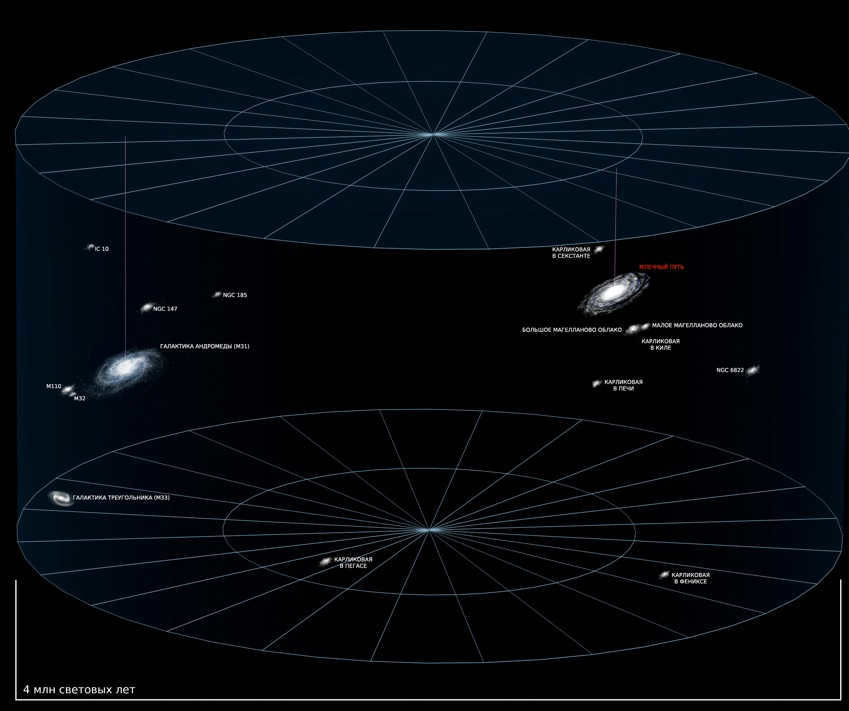
The Local Group of Galaxies is a collection of more than 50 galaxies that are gravitationally interconnected, with the Milky Way being one of them.
Overview
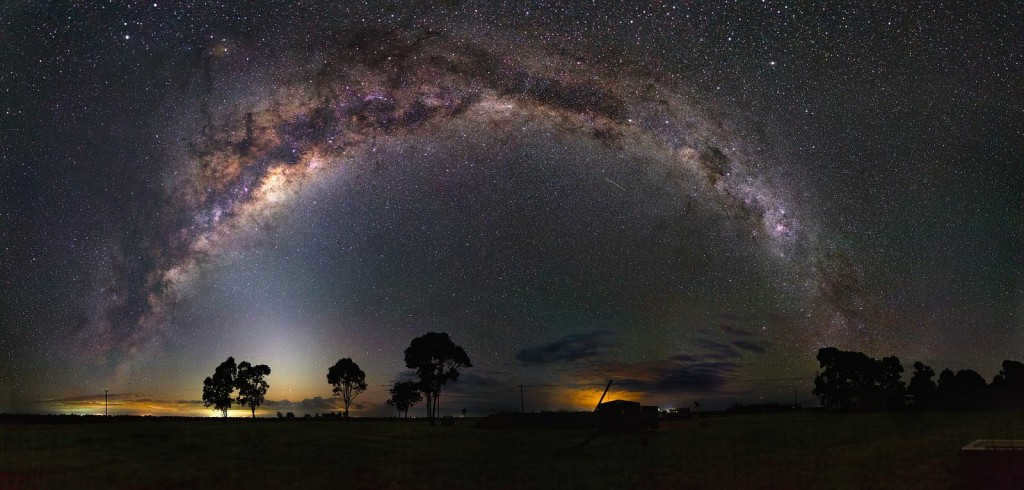
The Local Group of Galaxies is an astronomical phenomenon that never fails to captivate our imaginations. The vastness of the cosmos is something that humans struggle to fully grasp. As we gaze up at the night sky and delve into the pages of popular astronomy books, we are constantly astounded by the sheer scale of the universe. The enormity of celestial objects can be so immense that our minds struggle to comprehend their true size. The Local Group of galaxies serves as a prime example of one such colossal entity in outer space.
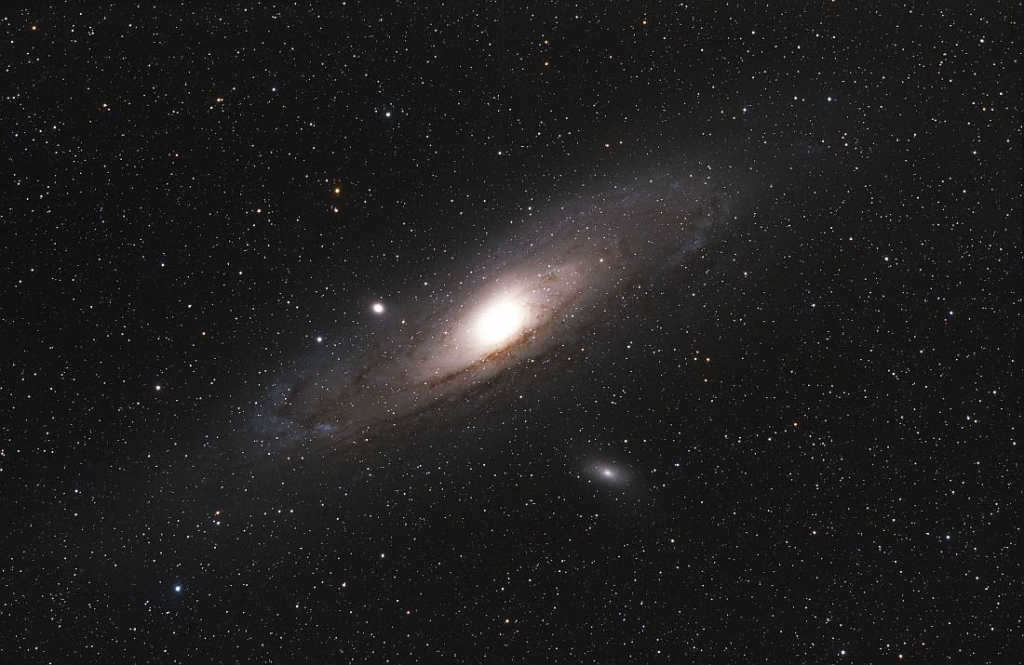
As of 2015, there are more than 50 galaxies of various sizes in the Local Group. The Milky Way, Andromeda, and Triangle galaxies are the largest objects in this system. These three largest galaxies have their own groups of galaxies connected to them by gravitational forces. The major galaxies themselves, Andromeda, Triangle, and the Milky Way, are also held together by gravitational forces and are surrounded by space with a common center of mass.
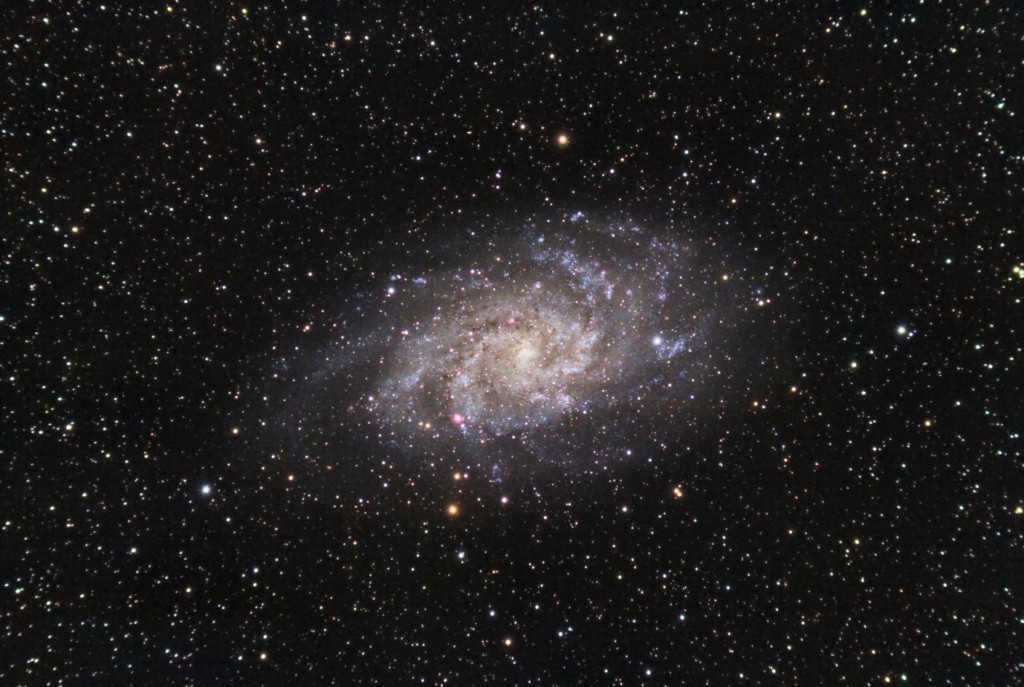
The Triangle is home to the Galaxy M33, a captivating sight in the night sky.
Aside from the prominent galaxies and their subgroups, the local group encompasses various dwarf galaxies that defy categorization due to their unique positioning. The Local Group boasts an array of galaxy types, including spiral, elliptical, dwarf elliptical, dwarf spheroidal, and irregular galaxies. It’s conceivable that scientists may uncover novel galaxy types in the coming decades, ones that remain undiscovered to this day. Given the ongoing efforts of astronomers worldwide, the study of the local group remains an active and fruitful pursuit.
Which galaxies are part of the local group?
The local group comprises over 50 entities, each being a galaxy of varying sizes. These galaxies are interconnected through gravitational forces, revolving around a shared center of mass in the vastness of space. It is widely believed that the local group’s galaxies share a similar age, estimated at around 13 billion years. Additionally, their composition suggests a common origin for these celestial objects.
Studies of galaxies within the local group have revealed that they possess a specific configuration, meaning that they are not randomly arranged, but rather organized in a purposeful manner. The majority of the galaxies in the local group are situated along an imaginary line that can be drawn between the Milky Way and the Andromeda Nebula. The smaller galaxies tend to cluster around the three prominent galaxies: the Milky Way, Andromeda, and the Triangle.
The subgroup of the Milky Way galaxy
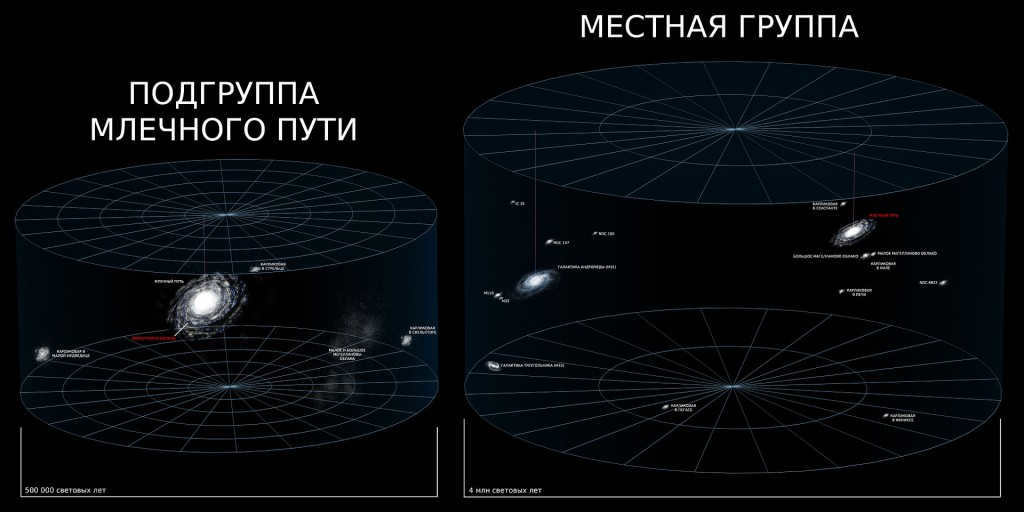
The Milky Way Galaxy may not be the largest galaxy in the observable Universe, but it holds significant importance as it serves as the home to the Solar System and, consequently, to us. Within the vast expanse of the Universe, the Milky Way galaxy is a part of a local group of galaxies, acting as a central hub of sorts. Positioned at its core is the Milky Way itself, with its various satellites orbiting around it. Currently, there are a total of fourteen satellites within this local group, including notable ones such as the Big Dipper, Little Dipper, Big Dog, Sagittarius, Dragon, Sculptor, Lion, Kiel, and others.
Previously, it was believed that the Large and Small Magellanic Clouds were part of a subgroup of the Milky Way. However, a fascinating discovery was made in 2006 with the assistance of the Hubble telescope – these objects are moving at an exceptionally high speed compared to the other satellites of the Milky Way. This suggests that they may not be gravitationally bound to our galaxy.
Despite this, the trajectory of the Large and Small Magellanic Clouds indicates that in approximately four billion years, they will be engulfed by the Milky Way galaxy. Similarly, the Milky Way itself is at risk of being consumed by its massive neighbor, the Andromeda Nebula.
The Andromeda subgroup: a unique perspective
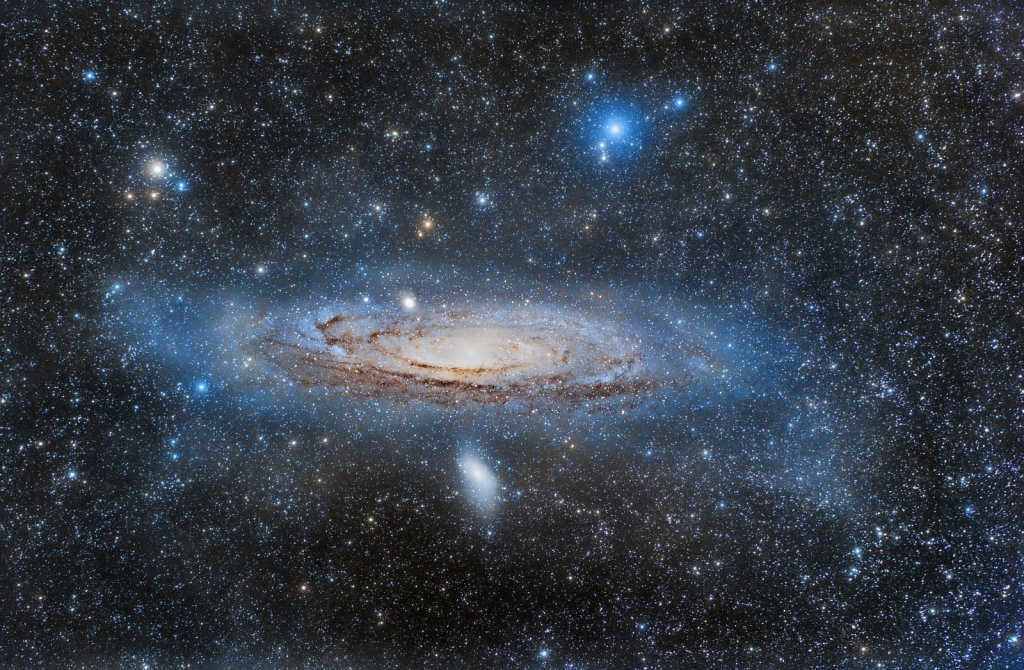
Andromeda Galaxy M31 and its satellites
The Andromeda Galaxy is situated approximately 2.5 million light-years away from our own Milky Way. It holds the distinction of being the nearest galaxy to us, although it is unfortunately not easily observable due to its edge-on orientation with respect to Earth. It is believed that the gravitational forces exerted by the Andromeda Nebula, which is almost twice the size of our Milky Way, will ultimately lead to the merging of the two galaxies in approximately 5 billion years, with Andromeda absorbing the Milky Way in the process.
Subgroup of a Triangle
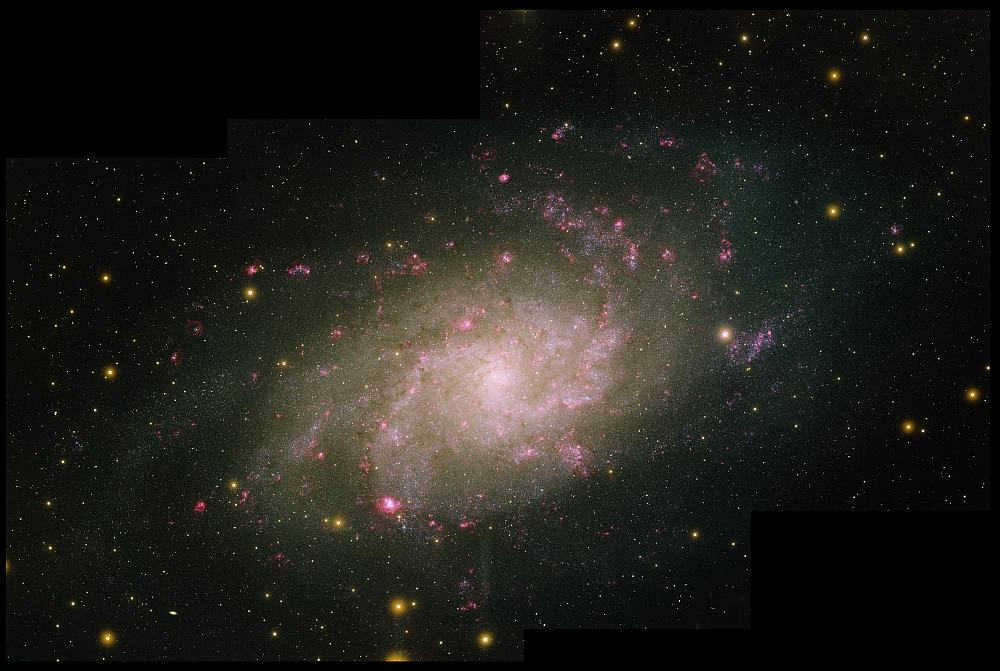
The M33 galaxy, also known as the Triangle galaxy, is relatively small compared to other galaxies in the universe, with a diameter of only 50,000 light-years. However, it still holds the distinction of being the third largest galaxy in the local group. Scientists have identified three potential satellites of the Triangle Galaxy: Triangle I, Andromeda II, and the Pisces dwarf galaxy.
Resources on the subject
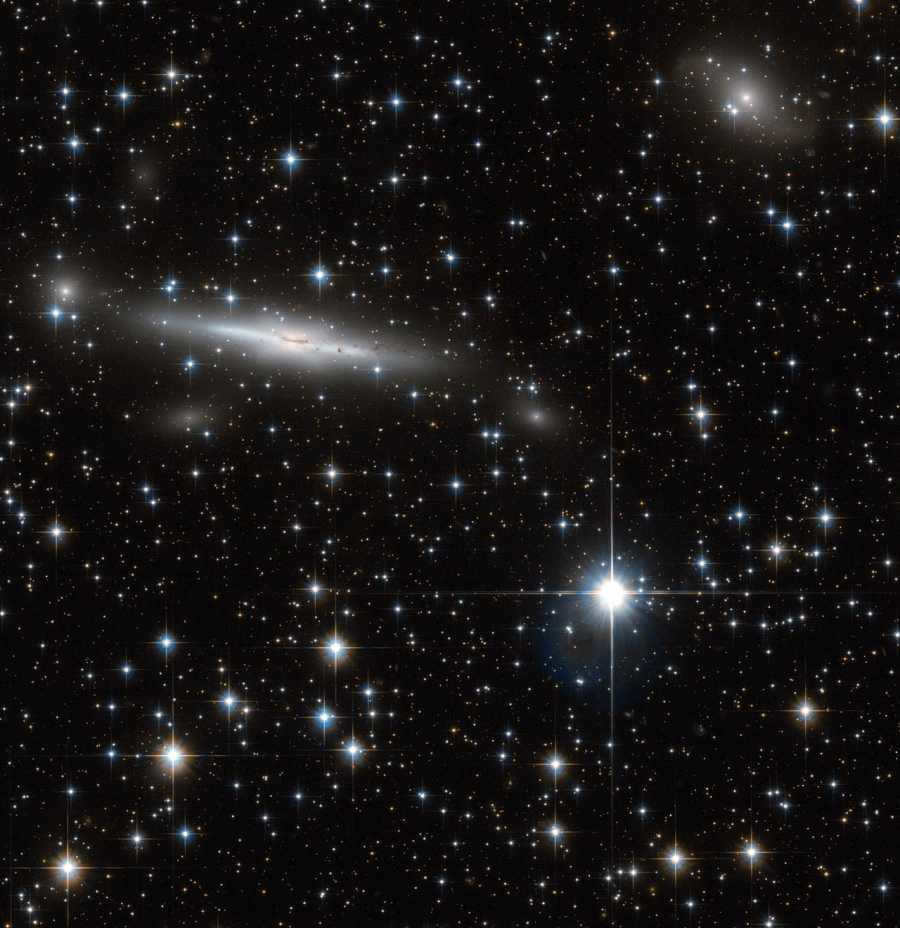
Regrettably, there is still no conclusive evidence to suggest that the aforementioned satellites constitute a singular entity alongside the Triangle Galaxy. For instance, the dwarf galaxy known as Andromeda II is situated roughly equidistant between the Andromeda Nebula and the Triangle Galaxy. It remains uncertain as to which of these two galaxies it is gravitationally associated with. The prevailing belief among most scientists is that it does indeed belong to the Triangle, but there are dissenting astronomers who argue that this object is actually part of the Andromeda Nebula. They even refer to this dwarf galaxy by a different name – Andromeda XXII. Only through further observations and investigation of this object will it be possible to ascertain the truth: to which of the two local subgroups does this object truly belong?
Engaging Information
After extensively examining the arrangement, makeup, and overall details of the nearby cluster of galaxies, we are excited to present a handful of captivating facts pertaining to this celestial entity.
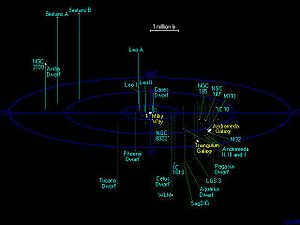
The Local Group of Galaxies is a collection of galaxies that are gravitationally bound together. It is made up of the Milky Way galaxy and the Andromeda Galaxy, known as M31.
There are more than 50 galaxies in the local group. The center of mass of the local group lies along the line connecting the Milky Way and the Andromeda Galaxy. The number of galaxies in the local group is constantly growing as new ones are discovered. The local group can be divided into different subgroups of galaxies.
- The Milky Way group is composed of the Milky Way galaxy itself, as well as its 14 known satellites (as of 2005), which are smaller, irregular (irregular), dwarf galaxies.
- The M31 group is quite similar to the Milky Way group: at the center of the group is M31, a massive spiral galaxy. Most of its 18 known satellites (as of 2005) are also dwarf galaxies.
- Triangle Group – The Triangle Galaxy and its potential satellites.
- Other dwarf galaxies that do not fit into any of the aforementioned groups.
The cross section of the Local Group is approximately one megaparsec. The Local Group is a part of a local supergroup known as the Virgo Supergroup, in which the Virgo Cluster plays a significant role.
Members of the Local Group
Notes
References
Wikimedia Foundation. 2010.
Helpful
Discover the meaning of “Local group of galaxies” in other dictionaries:
LOCAL GROUP OF GALAXIES – consists of the Galaxy and neighboring galaxies that together form a unified system. The local group of galaxies consists of approximately 20 known galaxies, with distances not exceeding about 1 Mpc. It includes the Magellanic Clouds and… … … Big Encyclopedic Dictionary
local group of galaxies – comprises the Galaxy and neighboring galaxies that form a single system. The local group of galaxies consists of over 20 known galaxies, with distances not exceeding about 1 Mpc, including the Magellanic Clouds and… … … Encyclopedic Dictionary
The Local Group is a collection of galaxies that are close to each other and have distances of no more than about 1 Mpc, which is equivalent to approximately 3 million light-years. It is comprised of two major groups, as well as various dwarf galaxies that are scattered throughout, making a total of around 30 members. Within one of the groups, there is a notable galaxy called the Milky Way, which is part of a unified system with other galaxies that are in close proximity. This system includes approximately 20 known galaxies, such as the Magellanic Clouds and the Andromeda Nebula, all of which have distances below the 1 Mpc mark. The Local Group is commonly referred to as a gravitationally bound group, as it consists of galaxies that are held together by gravitational forces. Some of the most well-known galaxies in the Local Group include the Milky Way, the Andromeda galaxy (M31), and the Triangle galaxy. This information can be found in various sources, such as the Big Soviet Encyclopedia, the Natural History Encyclopedic Dictionary, the Astronomical Dictionary, and Wikipedia.
A galaxy cluster is a group of galaxies that are relatively close to each other and held together by gravitational forces. There are over 3,000 known galaxy clusters, with membership ranging from a few dozen to several thousand galaxies. One example of a galaxy cluster is… … … The Encyclopedic Dictionary of Astronomy
A galaxy cluster refers to a collection of galaxies that are closely spaced and bound together by the force of gravity. There are more than 3,000 known galaxy clusters, varying in size from a few dozen to several thousand galaxies. One specific instance of a galaxy cluster is… … … The Big Encyclopedic Dictionary of Astronomy

